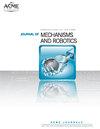Locust-inspired Jumping Mechanism Design and Improvement Based on Takeoff Stability
IF 3.2
4区 计算机科学
Q2 ENGINEERING, MECHANICAL
Journal of Mechanisms and Robotics-Transactions of the Asme
Pub Date : 2023-10-17
DOI:10.1115/1.4063406
引用次数: 0
Abstract
Abstract Locusts keep their bodies moving in a straight line during the takeoff and maintain the body stable during the whole jumping with small pitching motions, ensuring both kinematic and dynamic stability to reach their intended destinations. Inspired by locusts’ jumping performance, the Stephenson II six-bar jumping mechanism is adopted to mimic the kinematic stability of locusts’ takeoff and a dynamic model is developed to analyze the impacts of the torsional spring location, the spring stiffness, and the location of the equivalent body bar centroid on the jumping performance. Furthermore, a revised eight-bar jumping mechanism is proposed to solve the difficulty in realizing dynamic stability using the six-bar mechanism, as the moments of momentum of each component around the overall centroid are positive and contribute together to the counterclockwise rotation of the jumping. The dynamic modeling shows that the mass of the equivalent tarsus bar plays an important role in realizing the dynamic stability for the eight-bar jumping mechanism. Finally, two kinds of jumping robots are designed, fabricated and tested with jumping performance recorded by high-speed cameras, which validates the impacts of the mass of the equivalent tarsus bar on the jumping stability in the eight-bar jumping mechanism.基于起飞稳定性的蝗虫启发跳跃机构设计与改进
蝗虫在起飞过程中保持身体的直线运动,在整个跳跃过程中保持身体的稳定,并以较小的俯仰运动来保证身体的运动学和动力学稳定性,从而到达预定的目的地。以蝗虫的跳跃性能为灵感,采用Stephenson II型六杆跳跃机构模拟蝗虫起飞的运动稳定性,并建立动力学模型,分析扭转弹簧位置、弹簧刚度和等效体杆质心位置对跳跃性能的影响。此外,提出了一种改进的八杆跳跃机构,以解决六杆机构难以实现动态稳定的问题,因为每个部件在整体质心周围的动量矩都是正的,并且共同促进了跳跃的逆时针旋转。动力学建模表明,等效跗杆的质量对实现八杆跳跃机构的动态稳定性起着重要作用。最后,设计、制作了两种跳跃机器人,并进行了高速摄像机记录的跳跃性能测试,验证了等效跗骨杆质量对八杆跳跃机构中跳跃稳定性的影响。
本文章由计算机程序翻译,如有差异,请以英文原文为准。
求助全文
约1分钟内获得全文
求助全文
来源期刊

Journal of Mechanisms and Robotics-Transactions of the Asme
ENGINEERING, MECHANICAL-ROBOTICS
CiteScore
5.60
自引率
15.40%
发文量
131
审稿时长
4.5 months
期刊介绍:
Fundamental theory, algorithms, design, manufacture, and experimental validation for mechanisms and robots; Theoretical and applied kinematics; Mechanism synthesis and design; Analysis and design of robot manipulators, hands and legs, soft robotics, compliant mechanisms, origami and folded robots, printed robots, and haptic devices; Novel fabrication; Actuation and control techniques for mechanisms and robotics; Bio-inspired approaches to mechanism and robot design; Mechanics and design of micro- and nano-scale devices.
 求助内容:
求助内容: 应助结果提醒方式:
应助结果提醒方式:


